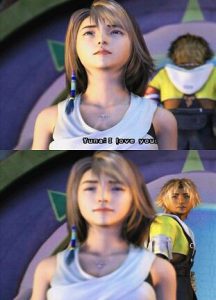In our recent articles, we have often covered culturalization. It is the process that brings the product closer to the culture of the target language, delivering the right messages to establish new relations between different cultures. But, practically, how is it done? Actually, there are many techniques that can be used: it is up to the localization team to choose the most appropriate one to the examined context.
Some Culturalization Techniques
Two widely used culturalization techniques are the cultural filtering and the information change.
Cultural filtering consists of replacing cultural elements with others that can serve the same purpose. In this way, the translation does not affect the general comprehension and the enjoyment of the work from the player perspective. For example, in the Japanese Final Fantasy X (Square Soft, 2001), “arigatou“, the one pronounced by Yuna in the ending cut-scenes, was translated as “I love you”. In fact, “arigatou” has many different nuances in Japanese that are not limited to “thank you”. An additional necessity was finding a word that could efficiently adapt to the labial.

Information change, instead, is a strategy used in video games with cultural references which are detrimental to the game experience. In these cases, the reference is completely deleted. Those references often allude to religion, history or specific political event. It does not mean that they must be offensive elements: in this group are included all those elements that would take too long to be explained in a reasonable way.
This decision is often related to the video game content rating system and, to compensate for this loss, localizators often include new cultural references in order to give a more familiar look to the product. For example, still in Final Fantasy X, an event called Raiheigen no raibu (Thunder’s Land Concert) was translated as Yunapalooza in the North-American release. It is a pun based on Yuna, one of the protagonists, and Lollapalooza, an American rock music festival.
Opposition to Culturalization
A wrong and common idea is that culturalization of a video game requires to rethink the work from scratch. This perception brings many developers and localizators to not confront with difficult issues like geopolitical ones in order to avoid possible controversies.
Actually, culturalization is a surgical task in which the localizator provides as few as possible alterations to the video game. For example, it might involve changing some words, a specific symbol or some character design. The goal is to change a product just to guarantee its distribution in the target market.
Before working on a video game, the degree of risk must be considered. A clear offence could indeed preclude the access to the target market, while some reasonable risks could be ignored if they might just raise some concerns.





